The drive to make homes more accessible has gained significant traction over recent years, and rightly so. Everyone deserves the freedom to move around their living space with ease, regardless of physical limitations. Disabled lifts have emerged as a vital tool in ensuring that homes are safe, accessible, and comfortable for everyone. In this article, we delve deep into the transformative role of disabled lifts and explore the challenges faced in making homes universally accessible.
The Need for Accessibility
Accessibility in homes isn’t merely a luxury—it’s a necessity. With a rising aging population and a significant portion of the population living with disabilities, homes need to be designed or retrofitted to cater to everyone’s needs. According to The World Health Organization, over a billion people experience some form of disability. This underscores the imperative for accessible housing solutions.

Disabled Lifts: A Step Towards Independence
For many with mobility challenges, staircases can be formidable barriers. Disabled lifts offer a practical and dignified solution, providing users with the independence to access different parts of their home without assistance. These lifts can be seamlessly integrated into existing homes, often requiring minimal structural modifications. With the help of a professional disabled lift installer, homeowners can ensure a safe and efficient installation process.
Challenges in Making Homes Accessible
While the technology and solutions are available, several challenges persist in the realm of home accessibility:
- Lack of Awareness: Many homeowners are unaware of the range of accessibility solutions available to them. More needs to be done to educate the public on the benefits of accessible home modifications.
- Cost Implications: Installing disabled lifts or making other accessibility modifications can be costly. While many regions offer subsidies or grants, they often don’t cover the entire expense.
- Space Constraints: Particularly in older homes, space can be a limitation. Innovative solutions and custom designs are sometimes needed to integrate lifts without compromising the home’s aesthetics or functionality.
The Broader Impacts of Accessible Homes
Beyond mere mobility, accessible homes have profound psychological and social impacts. Here’s how:
- Increased Social Interaction: Being able to move around one’s home with ease can significantly boost interactions with family members, reducing feelings of isolation.
- Enhanced Safety: Falls are a leading cause of injury among the elderly. By removing barriers and potential trip hazards, the risk of falls is substantially reduced.
- Empowerment and Dignity: Independent mobility, even within one’s home, can restore a sense of control and dignity, profoundly impacting one’s mental well-being.
Looking to the Future: Smart Homes and Accessibility
The advent of smart homes provides an exciting avenue for enhanced accessibility. Voice-activated systems, remote-controlled doors, and AI-driven care robots are all emerging technologies that can further assist those with disabilities. A study from the Pew Research Center suggests that smart home technologies can be particularly beneficial for seniors and those with disabilities, marking a new frontier in home accessibility.
Embracing Universal Design
While disabled lifts are a significant step towards universal accessibility, there’s a broader movement at play. Universal design is an architectural philosophy that emphasizes creating spaces that can be used by everyone, irrespective of their age or physical condition. As highlighted by the National Disability Authority, it’s about creating an environment that can be accessed, understood, and used to the greatest extent possible by all people.
Conclusion
The journey towards universally accessible homes is ongoing. While challenges remain, the strides made in recent years are promising. By embracing technologies like disabled lifts and adopting principles of universal design, we inch closer to a world where every home is a haven of safety, comfort, and freedom for all.
